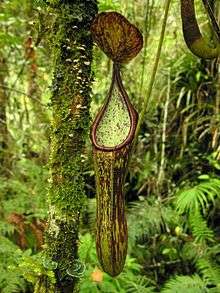Nepenthes copelandii
| Nepenthes copelandii | |
|---|---|
 | |
| A hanging lower pitcher of N. copelandii from Mount Apo | |
| Scientific classification | |
| Kingdom: | Plantae |
| (unranked): | Angiosperms |
| (unranked): | Eudicots |
| (unranked): | Core eudicots |
| Order: | Caryophyllales |
| Family: | Nepenthaceae |
| Genus: | Nepenthes |
| Species: | N. copelandii |
| Binomial name | |
| Nepenthes copelandii Merr. ex Macfarl. (1908)[1] | |
| Synonyms | |
| |
Nepenthes copelandii (/nᵻˈpɛnθiːz koʊpˈlændi.aɪ/; after Edwin Copeland) is a species of pitcher plant native to the island of Mindanao in the Philippines. Originally known from Mount Apo near Davao City and Mount Pasian near Bislig, it has since been discovered on a number of peaks throughout Mindanao.[6] It may also be present on the nearby island of Camiguin.[7][8][9] The species has a wide altitudinal distribution of 1100–2400 m above sea level.[6] Nepenthes copelandii has no known natural hybrids.[10] No forms or varieties have been described.
The Mount Apo form has been cultivated by Australian hobbyists since the early 1980s, the taxon being referred to as "N. sp. Philippines No. 2". Plants from Mount Pasian only entered cultivation much later.[11]
Nepenthes copelandii belongs to the informal "N. alata group", which also includes N. alata, N. ceciliae, N. extincta, N. graciliflora, N. hamiguitanensis, N. kitanglad, N. kurata, N. leyte, N. mindanaoensis, N. negros, N. ramos, N. saranganiensis, and N. ultra.[3][12][13][14] These species are united by a number of morphological characters, including winged petioles, lids with basal ridges on the lower surface (often elaborated into appendages), and upper pitchers that are usually broadest near the base.[3][12]
In his Carnivorous Plant Database, taxonomist Jan Schlauer treats N. copelandii as a heterotypic synonym of N. alata.[15]
References
- ↑ Macfarlane, J.M. 1908. Nepenthaceae. In: A. Engler. Das Pflanzenreich IV, III, Heft 36: 1–91.
- ↑ Danser, B.H. 1928. 1. Nepenthes alata Blanco. [pp. 258–262] In: The Nepenthaceae of the Netherlands Indies. Bulletin du Jardin Botanique de Buitenzorg, Série III, 9(3–4): 249–438.
- 1 2 3 Cheek, M. & M. Jebb 2013. Typification and redelimitation of Nepenthes alata with notes on the N. alata group, and N. negros sp. nov. from the Philippines. Nordic Journal of Botany 31(5): 616–622. doi:10.1111/j.1756-1051.2012.00099.x
- ↑ Clarke, C. & C.C. Lee 2012. A revision of Nepenthes (Nepenthaceae) from Gunung Tahan, Peninsular Malaysia. Gardens' Bulletin Singapore 64(1): 33–49.
- ↑ Schlauer, J. N.d. Nepenthes alata. Carnivorous Plant Database.
- 1 2 McPherson, S.R. & V.B. Amoroso 2011. Field Guide to the Pitcher Plants of the Philippines. Redfern Natural History Productions, Poole.
- ↑ Macfarlane, J.M. 1927. The Philippine species of Nepenthes. The Philippine Journal of Science 33(2): 127–140.
- ↑ Co, L. & W. Suarez 2012. Nepenthaceae. Co's Digital Flora of the Philippines.
- ↑ Heinrich, V.B. 2009. Philippines: Volcanoes Nepenthes and more. Carnivorous Plants in the tropics, October 28, 2009.
- ↑ McPherson, S.R. 2009. Pitcher Plants of the Old World. 2 volumes. Redfern Natural History Productions, Poole.
- ↑ Bourke, G. 2010. Plant profile: Nepenthes copelandii. Captive Exotics Newsletter 1(2): 9.
- 1 2 Cheek, M. & M. Jebb 2013. Recircumscription of the Nepenthes alata group (Caryophyllales: Nepenthaceae), in the Philippines, with four new species. European Journal of Taxonomy 69: 1–23. doi:10.5852/ejt.2013.69
- ↑ Cheek, M. & M. Jebb 2013. Nepenthes ramos (Nepenthaceae), a new species from Mindanao, Philippines. Willdenowia 43(1): 107–111. doi:10.3372/wi.43.43112
- ↑ Cheek, M. & M. Jebb 2013. Nepenthes ultra (Nepenthaceae), a new species from Luzon, Philippines. Blumea, published online on October 24, 2013. doi:10.3767/000651913X675124
- ↑ Schlauer, J. N.d. Nepenthes copelandii. Carnivorous Plant Database.
Further reading
- Amoroso, V.B., L.D. Obsioma, J.B. Arlalejo, R.A. Aspiras, D.P. Capili, J.J.A. Polizon & E.B. Sumile 2009. Inventory and conservation of endangered, endemic and economically important flora of Hamiguitan Range, southern Philippines. Blumea 54(1–3): 71–76. doi:10.3767/000651909X474113
- Amoroso, V.B. & R.A. Aspiras 2011. Hamiguitan Range: a sanctuary for native flora. Saudi Journal of Biological Sciences 18(1): 7–15. doi:10.1016/j.sjbs.2010.07.003
- Bonhomme, V., H. Pelloux-Prayer, E. Jousselin, Y. Forterre, J.-J. Labat & L. Gaume 2011. Slippery or sticky? Functional diversity in the trapping strategy of Nepenthes carnivorous plants. New Phytologist 191(2): 545–554. doi:10.1111/j.1469-8137.2011.03696.x
- Cheek, M.R. & M.H.P. Jebb 2001. Nepenthaceae. Flora Malesiana 15: 1–157.
- (German) Gronemeyer, T. 2008. Nepenthes auf den Philippinen – ein Reisebericht. Das Taublatt 60: 15–27.
- (German) McPherson, S. & T. Gronemeyer 2008. Die Nepenthesarten der Philippinen: eine Fotodokumentation. Das Taublatt 60: 34–78.
- Borneo Exotics: Nepenthes copelandii – Discovery and Rediscovery
External links
- Photographs of N. copelandii at the Carnivorous Plant Photofinder